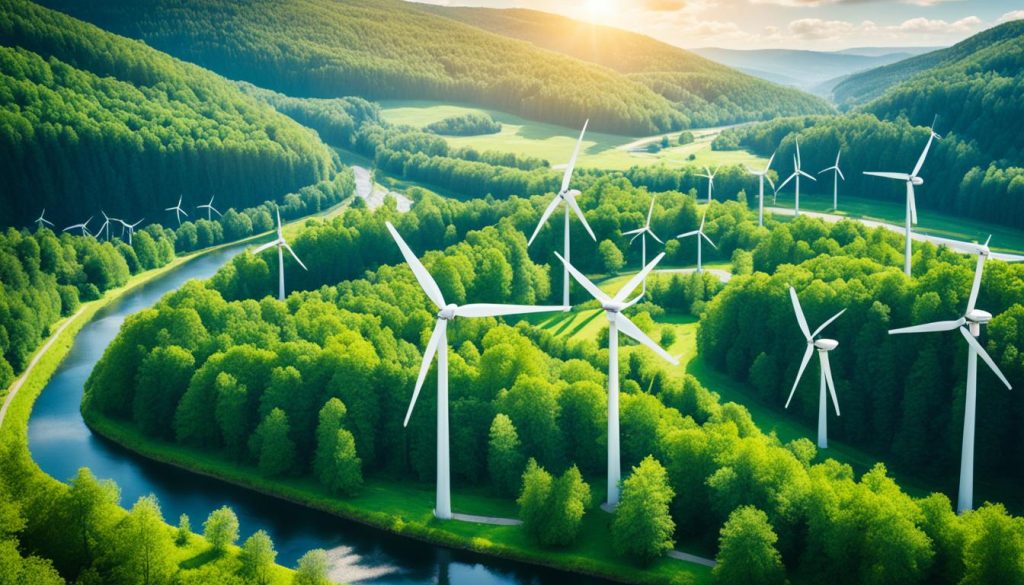Germany leads the world in sustainability, earning praise for its eco-friendly actions. It shows strong environmental responsibility, making it an example for other nations aiming for sustainable growth to follow.
Germany’s environmental policy covers everything from renewable energy to farming, city designs, and water management. Its efforts have decreased carbon emissions, improved people’s lives, and saved natural resources.
The switch to renewable energy sources is a key part of Germany’s green strategy. By adopting solar and wind energy, the country has cut down on greenhouse gases. This makes Germany a top player in the renewable energy field.
Germany also promotes sustainable means of transport. It supports public transport, biking, and electric cars with great infrastructure and policies. This has helped in reducing air pollution and city traffic jams.
Besides energy and transport, Germany focuses on circular economy concepts. It aims at reducing waste, recycling more, and reusing resources. This approach helps build a sustainable economy with less waste.
In agriculture, Germany encourages organic farming and protecting biodiversity. These measures are vital for a sustainable food system that benefits both people and the planet.
In urban areas, Germany opts for green buildings and parks. It uses energy wisely and chooses sustainable materials. This approach makes cities better to live in and helps fight climate change.
Germany leads in managing water sustainably as well. It saves water, prevents pollution, and protects water habitats. This ensures everyone has access to clean water.
The country works hard to protect nature and wildlife. It creates safe areas for animals and plants, helping preserve biodiversity for the future.
Germany sees sustainable tourism as a way to grow economically while caring for the environment and cultures. It offers eco-friendly travel choices and experiences.
Green financing in Germany supports eco-friendly projects and ideas. The country encourages investing in green solutions, helping everyone move towards a greener future.
Germany stresses the importance of learning about the environment. Through education and campaigns, it aims to foster a culture of sustainability among its people.
Working together is crucial for Germany’s green goals. It partners with global bodies, governments, and communities to share knowledge and achieve global sustainability targets.
Despite challenges, Germany is committed to being eco-friendly. Its dedication to innovation keeps it hopeful about leading sustainable development actions.
Key Takeaways:
- Germany has emerged as a global leader in sustainability, implementing a range of eco-friendly initiatives.
- The country has made significant progress in renewable energy transition, sustainable transportation, circular economy practices, and sustainable agriculture.
- Germany focuses on green building, sustainable water management, biodiversity conservation, sustainable tourism, and green financing.
- Environmental education, collaboration, and partnerships are crucial elements of Germany’s sustainability approach.
- Despite challenges, Germany remains committed to driving sustainability and leading the way towards a greener future.
Overview of Germany’s Environmental Policy
Germany is known for taking environmental protection seriously. It has a strong plan for sustainable growth. This includes many laws and initiatives aimed at keeping the environment clean and healthy.
Key Focus Areas
Germany focuses on many environmental issues. This includes fighting climate change, moving towards greener energy, managing waste, saving biodiversity, and looking after water. The goal is to cut down harmful emissions, use more renewable energy, and use resources wisely.
Legal Framework
The foundation of Germany’s approach is its detailed legal framework. This contains laws and rules that encourage eco-friendly habits. It makes sure the country meets international environmental standards and plans for a sustainable future.
Renewable Energy
Renewable energy is central to Germany’s environmental plans. Investments in wind, solar, and biomass energy have decreased use of coal and nuclear power. Switching to clean energy supports climate goals and boosts the economy by creating jobs in the green sector.
Sustainable Transportation
Germany is also working on making transportation greener. It supports electric cars, builds better public transport, and makes it easier for people to cycle and walk. There’s a big push for infrastructure that supports eco-friendly travel.
Environmental Education and Awareness
Teaching people about the environment is key in Germany. Through education and campaigns, it aims to make everyone more aware of environmental issues. The hope is to inspire eco-friendly decisions in everyday life.
Renewable Energy Transition in Germany
In recent years, Germany has taken the lead in renewable energy. They have moved from using fossil fuels to cleaner, sustainable sources. This change is known as the energy transition. It is driven by policies, tech advances, and support from the public.
Germany’s government wants to cut down on greenhouse gases and tackle climate change. With the Energiewende policy, the goal is to stop using nuclear power and coal less. This plan aims to boost renewable energy in Germany’s energy mix.
To hit these goals, Germany has introduced ways to encourage renewable energy. For example, feed-in tariffs guarantee a price for the electricity from renewables. This boost in investment has led to more wind, solar, and biomass plants.
Germany is also focusing on renewables in heating and transport. There are benefits for installing solar heating systems and for using electric vehicles. This includes more charging points for cars.
The move to renewable energy has cut carbon emissions and opened up new economic paths. The sector has grown, creating jobs and boosting the economy. Companies are thriving in the renewable energy system’s design, manufacturing, and installation.
The Expansion of Renewable Energy Infrastructure
Germany’s energy transition includes expanding renewable infrastructure. Investments have been made in wind farms, solar parks, and other projects. This has greatly increased the country’s capacity for renewable energy.
The table below provides an overview of the installed capacity of renewable energy sources in Germany:
| Renewable Energy Source | Installed Capacity (GW) |
|---|---|
| Wind | 64 |
| Solar | 55 |
| Biomass | 9 |
| Hydroelectric | 5 |
Wind and solar power lead in Germany’s renewable energy source. These sources are reliable and cost-effective. They are key in powering Germany’s energy switch.
To sum up, Germany’s renewable energy shift shows its dedication to sustainability and lower carbon use. The country has seen a big increase in renewable energy through policy, technology, and public effort. The growth of renewable infrastructure is essential in this shift. Germany’s ongoing investment in renewables serves as an example for others to follow for a sustainable future.
Sustainable Transportation Initiatives
Germany leads in sustainable transportation, focusing on eco-friendly travel. Its efficient public transport system, cycling paths, and push for electric vehicles help cut carbon emissions.
Public transport is key in Germany. Trains, trams, and buses offer easy options for all. They help lessen traffic jams and cut emissions, making them a green choice.
Cycling gets special attention in Germany. With many bike lanes and facilities, it’s easy and safe to cycle. This approach promotes a healthy, car-less lifestyle.
Germany is also keen on electric vehicles (EVs) to reduce pollution. With incentives like money savings and tax breaks, more EVs are seen on the roads. This switch is greening the transport sector.
Public Transportation Statistics
| Category | Statistics |
|---|---|
| Number of Public Transport Passengers (annually) | Over 10 billion |
| Length of Tram and Light Rail Network | Over 8,500 km |
| Length of Railway Network | Almost 34,000 km |
| Number of Bicycles in Germany | Over 75 million |
Germany’s drive for sustainable transport isn’t just governmental. Companies and citizens alike join in, seeking new ways to lower emissions and improve mobility. Through this united effort, Germany marches towards a greener, more efficient future.
Circular Economy Practices

In Germany, circular economy practices boost sustainability and waste management. They have set up strong systems for using resources wisely. They aim to cut down waste and increase recycling.
Waste management is central to Germany’s circular economy. They’ve built comprehensive systems that focus on recycling and responsible waste disposal. Thanks to strict rules and good infrastructure, materials flow round and round.
Germany’s strategy starts with the waste hierarchy: reduce, reuse, recycle, and recover. They focus on preventing waste first. If we can’t prevent it, we should reuse stuff instead of throwing it away. This saves resources and helps the environment.
Recycling is where Germany shines. They sort waste carefully and have top-notch recycling plants. High recycling rates are achieved for many materials. This includes things like packaging, electronics, and even building waste.
To show how well Germany’s doing, here’s a table of their recycling rates:
| Waste Stream | Recycling Rate |
|---|---|
| Plastic Packaging Waste | 65% |
| Paper and Cardboard | 86% |
| Glass | 90% |
| Electronics | 77% |
| Organic Waste | 68% |
The high recycling rates show Germany’s dedication to a circular economy. Recycling saves valuable materials and reduces bad environmental effects. This includes things like pollution and gas emissions.
But Germany’s efforts don’t stop at waste management. They also focus on designing products to be recycled easily. This helps create a system where materials are constantly reused.
Germany leads the way in using resources responsibly by following circular economy practices. Their focus on reducing waste and recycling sets a standard for other countries. They show how to support a sustainable economy.
Sustainable Agriculture and Food Innovation
In Germany, they focus a lot on farming that’s good for the planet. They aim to make high-quality, organic food.
They want to use fewer synthetic fertilizers and chemicals. Farmers there go for natural ways to keep crops healthy. They use things like crop rotation and composting.
The German government helps farmers switch to these greener methods. They offer money and support to those who farm organically. This helps make food production better for the environment.
Reduction of Pesticide Use
Germany has tough rules about pesticide use. They want to keep both nature and people safe. Farmers use smart strategies that include natural pest fighters.
They’re also using cool tech, like sensors and satellites, to cut down on fertilizer and pesticide use. This tech helps them put these things only where they’re really needed.
Plus, Germany is creating spaces on farms for nature to thrive. These areas attract helpful insects and wildlife. They keep farming lands healthy and balanced.
Support for Local and Organic Products
More people in Germany now want food that’s organic and local. The country helps by making it easier to know where and how food is grown. They use labels and certification programs.
Germany boosts farmers’ markets and community projects for fresh food. This supports greener farming and makes communities stronger. It bridges the gap between farmers and shoppers.
Innovative Food Production Technologies
Germany is leading the way with new food-growing tech. Things like vertical farming and hydroponics are big there. These methods are great for growing food all year without using much land or water.
They also use drones in farming now. Drones help check on crop health from the sky. This makes it easier for farmers to water, feed, and protect their plants just right.
Green Buildings and Urban Planning
Germany is leading in green building and city planning, aiming for eco-friendly and efficient cities. Their commitment to sustainability goes beyond just using renewable energy and eco transport. They focus on constructing energy-smart buildings that have a low environmental impact.
For these green buildings, the focus is on using daylight, effective insulation, and green materials. This helps in saving energy. Renewable energy sources like solar panels and wind turbines are also integrated. This makes the buildings produce their own clean electricity.
Germany puts importance on green certifications for buildings, like the LEED certification. It’s awarded to buildings that meet high sustainability standards. This highlights their dedication to environment-friendly and energy-efficient construction.
Sustainable Urban Development Projects and Initiatives
Germany’s efforts go beyond just buildings. They work on eco-friendly neighbourhoods and city projects, too. These projects enhance green spaces, make areas more walkable, and improve public transport. It’s all about creating green, efficient communities.
The “Stuttgart 21” project is turning Stuttgart’s railway station area into an eco-friendly urban area. It will have parks, green paths, and places where people can walk easily. It’s designed to make the environment healthier and better to live in.
Freiburg’s “Green City” project shows strong dedication to sustainable development. The city uses renewable energy, and has green roofs and eco-friendly travel options. This makes Freiburg a model for sustainable city living.
Germany’s focus on green building and planning is making a more eco-friendly future possible. By adopting energy-efficient and sustainable designs, Germany is showing the way towards a greener built environment. They’re setting an example for the world in the move towards sustainability.
Sustainable Water Management
In Germany, saving water is a big deal. The country uses many steps to use water wisely, keep it clean, and save it for later. They aim for everyone to use less water and keep it pure.
Water Conservation
Germany sees saving water as essential. The government and water groups work hard to cut down on water use. They focus on using water in a smart way.
Germany promotes gadgets that use less water in homes and businesses. Things like efficient toilets, eco-friendly washing machines, and clever watering systems are encouraged. This helps reduce wasted water and encourages everyone to use water carefully.
Regulating Water Usage
The German government makes sure water is used properly. They have rules to control how much water can be taken from nature. This helps keep everything in balance.
They give out permits that limit how much water businesses and farms can use. This keeps water levels safe. It avoids taking too much water and harming rivers and lakes.
Innovative Approaches
Germany is creative with its water solutions. They focus on using water more efficiently and cleaning used water well. They are leading in smart water use and recycling.
They use new systems for treating water right where it’s used. This eases pressure on big treatment plants and reduces pollution. Also, they reuse water smartly to cut down on waste.
Protecting Water Quality
Keeping water clean is a top goal in Germany. Safe, clean water is vital for people and wildlife. They have strict rules to stop water pollution.
Germany works hard to lower pollution from various sources. They make sure waste water is cleaned well and limit harmful discharges. Regular checks are done to keep water safe and clean.
| Benefits of Sustainable Water Management in Germany | Challenges in Sustainable Water Management |
|---|---|
| – Reduced water consumption and wastage | – Managing water scarcity in certain regions |
| – Preservation of water resources and ecosystems | – Balancing water usage for agriculture and industries |
| – Improved water quality and aquatic habitats | – Mitigating the impact of climate change on water resources |
| – Sustainable development and resilience | – Ensuring equitable access to clean water |
Germany’s way of managing water sets an example for the world. They focus on saving water, keeping it clean, and using it wisely. This shows their commitment to sustainability and taking good care of their water resources.
Biodiversity and Conservation Efforts
Germany is known for its dedication to protecting varied life forms within its boundaries. This includes forests, meadows, wetlands, and mountains, home to many species.
The German government has started many initiatives to keep this biodiversity safe. It has set up national parks and nature reserves across the country. These areas help endangered species survive. They also allow for research, teaching, and fun activities.
The National Park Berchetsgaden in the Bavarian Alps is a great example. It’s a place where animals like the Alpine ibex and the golden eagle live. People who love nature and researchers find it a fascinating place due to its landscapes and wildlife.
Endangered Species Protection
In Germany, saving endangered species is a big deal. Animals like the European bison, Eurasian lynx, and the gray wolf are being helped. They use breeding and bringing animals back into their natural habitats to increase their numbers.
Germany also works on making natural areas connect better. This helps animals move around and keeps their populations strong. It makes them better able to deal with changes in the environment.
Promoting Biodiversity in Urban Areas
Biodiversity matters in cities too, not just in wild areas. Germany promotes green spaces in urban places. Parks, gardens, and green roofs give homes to many plants and animals. These places make life better for people in cities by bringing nature closer.
| Conservation Initiative | Description |
|---|---|
| National Park System | The establishment of national parks and nature reserves across Germany to protect critical habitats and preserve biodiversity. |
| Endangered Species Protection | Conservation efforts dedicated to rehabilitating and protecting endangered species. |
| Ecological Connectivity | Initiatives that aim to connect fragmented habitats to enable the movement and gene flow of species. |
| Urban Biodiversity Promotion | The integration of green spaces in urban areas to support biodiversity and improve the well-being of city residents. |
Germany shows its dedication to nature by focusing on these initiatives. By saving endangered species, connecting nature areas, and adding green to cities, it leads in caring for the planet. This helps future generations enjoy a rich natural heritage.
Sustainable Tourism
Germany is famous not just for its exciting cities and rich culture but also for sustainable tourism. Its focus on protecting the environment and supporting green travel makes it a favourite for those looking for ethical travel chances.
Eco-Friendly Travel Options
In Germany, tourists have many green travel choices that lower tourism’s environmental impact. They can enjoy its beautiful sights and lovely towns by cycling or taking public transport. With well-kept cycle paths, visitors can enjoy nature and lower their carbon footprint.
Sustainable Accommodations
Germany offers various eco-friendly places to stay. Eco-hotels and charming bed and breakfasts that focus on saving energy and reducing waste are available. These places use renewable energy and have recycling initiatives to ensure guests have a comfortable stay while caring for the planet.
Initiatives Promoting Responsible Tourism
Germany has launched efforts to encourage responsible tourism. It focuses on educating people about being sustainable travellers through campaigns and workshops. Tourists learn about being eco-friendly and how to help preserve Germany’s natural and cultural treasures.
Germany also gives eco-tourism certifications to businesses that meet environmental and social standards. This helps tourists recognize and choose places that value sustainability, boosting eco-tourism in the country.
Germany is a top choice for eco-aware travellers with its stunning landscapes, cultural sites, and green practices. By opting for sustainable tourism in Germany, visitors help protect the environment and support local areas while having an unmatched travel experience.
Green Financing and Investment

Germany leads the way in sustainable development, focusing on green financing and investment. The country has set up various policies and incentives. These actions support projects meeting environmental goals.
Green bonds are vital for green financing in Germany. They fund eco-friendly projects like renewable energy, eco-friendly transportation, and efficient buildings. Green bonds let investors back sustainable projects and still make good returns.
Sustainable investment funds are also popular in Germany. These funds pick companies that are good for the environment, society, and governance. Through ESG criteria, these funds help grow businesses that care for our planet.
Banks and financial bodies in Germany are vital in backing eco-friendly projects. They provide special financing for green initiatives. Besides, they look at the environmental impact of their investments to stay in line with green values.
Germany’s Green Financing Landscape
Government actions and collaborations shape Germany’s green financing scene. Germany aims to cut carbon emissions and embrace a green economy. This ambition drives the country’s green financing strategies.
Financial institutions in Germany join sustainable investment networks and partnerships. These partnerships promote innovation in green financing. They also create chances for sustainable investments and financing green projects through teamwork.
Sustainable Investment Opportunities
Germany’s green initiatives offer many investment opportunities in renewable energy and clean tech. Investments help the economy turn greener, benefiting both the environment and investors.
Beyond traditional areas, Germany explores sectors like the circular economy, sustainable farming, and eco-tourism. These emerging fields are exciting for investors who want to make money in an eco-friendly way.
Challenges and Outlook
Germany faces challenges in green financing and investment, despite its progress. Issues like standardizing ESG reporting and improving transparency need work. Overcoming these challenges is essential for the growth of green financing.
The outlook for green financing in Germany is bright. The emphasis on sustainability will keep up the demand for green financial products and investments. Germany’s sustainable development commitment lays a solid base for a greener economy.
| Benefits of Green Financing in Germany | Challenges |
|---|---|
| 1. Promotes transition to a low-carbon economy | 1. Lack of standardized ESG reporting |
| 2. Supports environmentally friendly projects | 2. Limited transparency in sustainable investment products |
| 3. Attracts sustainable investment opportunities | 3. Ambiguity in guidelines for green financing |
| 4. Aligns financial goals with sustainability values | 4. Need for increased awareness and education |
Environmental Education and Awareness
Germany is big on teaching about the environment and getting everyone to live sustainably. The country is getting schools, local groups, and folks involved. This helps grow a sense of duty towards looking after our world.
Schools in Germany include lessons on how to keep the planet green. Kids learn about clean energy, how to manage waste, and why all creatures are important. This knowledge helps them make smart choices that help the planet in their daily lives.
The government and charities run campaigns to teach people how to live greener. These efforts show everyone how to recycle, save energy, and buy wisely. It’s all about learning to live in ways that don’t harm the earth.
Beyond regular lessons, Germany encourages learning by doing through special environmental projects. These might include going on walks in nature, planting trees, or joining in on science projects. It’s about touching, seeing, and feeling nature, growing a deep respect and care for it.
The Role of Communities and Businesses
It’s not just schools that matter. Local groups and businesses in Germany are also doing their part for the environment. There are local clubs, clean-ups, and projects that make people work together for a cleaner world.
Businesses aren’t behind either. They’re running their own green programs, showcasing eco-friendly products and teaching staff and customers how to be more sustainable. By making green choices a part of their brand, they help spread the word and make a bigger impact.
Partnerships and Collaboration
Germany knows working together is key for teaching about the environment. By teaming up – schools, universities, NGOs, and the government share what they know. This helps everyone learn the best ways to care for our planet.
Germany also works with other countries on environmental education. By sharing what they learn with the world, they help make a bigger difference. It’s about learning from others, sharing knowledge, and working together to face our planet’s challenges.
Germany’s big push on teaching everyone about the environment is leading to a greener future. By giving folks the tools they need to protect our world, Germany is creating a community ready to make a positive change.
| Benefits of Environmental Education and Awareness in Germany |
|---|
| 1. Increased public knowledge and understanding of environmental issues |
| 2. Adoption of sustainable practices in daily life |
| 3. Promotion of environmental consciousness and responsibility |
| 4. Generation of innovative solutions to environmental challenges |
| 5. Creation of a sustainable mindset and culture |
Collaboration and Partnerships
Working together across borders is key to overcoming environmental challenges globally. Germany knows it’s important to partner with other countries for a sustainable future. Together, they aim to reach shared sustainability goals.
Germany is involved in big efforts like the United Nations Sustainable Development Goals and the Paris Agreement on climate change. Through these global initiatives, it shares its knowledge and experience. This helps develop solutions that work around the world.
Sharing knowledge and best practices is one area where Germany excels in international teamwork. It regularly exchanges innovative ideas with other nations. This exchange helps Germany learn and adopt successful strategies for its own sustainability efforts.
Furthermore, Germany steps up as a leader in global sustainability. It pushes for more commitment to the environment in global forums and summits. Germany’s goal is to spark worldwide action and motivate other countries to focus on sustainability.
Additionally, Germany helps build capabilities in developing countries by offering support. It provides technical help, shares expertise, and gives financial aid. This support helps these countries adopt sustainable practices and policies for a lasting impact on the environment.
International Collaboration Projects
| Project | Description | Partners |
|---|---|---|
| Global Climate Action | Aims to accelerate the implementation of the Paris Agreement and promote climate action worldwide. | United Nations Framework Convention on Climate Change (UNFCCC), other countries |
| International Resource Efficiency Collaboration | Focuses on promoting resource efficiency, circular economy, and sustainable consumption and production patterns globally. | United Nations Environment Programme (UNEP), other countries |
| Transboundary Conservation Areas | Works towards the protection and management of shared ecosystems across borders, ensuring biodiversity conservation. | International Union for Conservation of Nature (IUCN), neighboring countries |
| Renewable Energy Partnership | Promotes the deployment of renewable energy technologies and enhances energy security globally. | International Renewable Energy Agency (IRENA), other countries |
Germany’s dedication to working with other countries shows its commitment to a greener future. By sharing knowledge and working on joint projects, Germany helps lead the way in environmental progress worldwide.
Challenges and Future Prospects

Germany is working hard to be more sustainable. It faces challenges like policy changes, winning public support, and economic factors.
Policy Changes
Germany needs regular policy updates to become greener. It’s tricky to keep policies in tune with environmental needs. Staying adaptable is key to keep moving forward with sustainability.
Social Acceptance
Getting people to accept and follow sustainable practices is another hurdle. Germany has made progress, but there’s more to do. Everyone must get on board to make a real difference.
Economic Considerations
Economic issues are crucial for Germany’s green future. The nation has to find a balance between being eco-friendly and economic growth. Innovative and sustainable business ideas are vital for a thriving green economy.
Yet, Germany’s outlook on sustainability is hopeful. The determination to create a greener future stays strong. With the right policies, social push, and innovation, Germany aims to be a leader in sustainability.
Germany is committed to innovation and setting a global standard. By facing sustainability challenges, Germany aims to inspire other countries. The goal is a sustainable future that can serve as a model for everyone.
Conclusion
We’ve looked at how Germany is leading in sustainability. They’ve made great progress in areas like green energy and eco-friendly policies. Germany is also improving sustainable transport and circular economy efforts.
Germany is dedicated to eco-friendly farming and food innovation. They’re also focusing on green buildings and protecting natural resources. Efforts in water conservation and protecting wildlife highlight their commitment.
Yet, Germany still has challenges to face on its sustainability journey. Continuing to invest in eco-friendly projects and education is vital. It’s also important to work together globally for lasting impact.
In conclusion, Germany’s work in sustainability is an example for the world. Their thorough approach and dedication stand out. Looking ahead, let’s take inspiration from Germany to create a greener future for everyone.
















